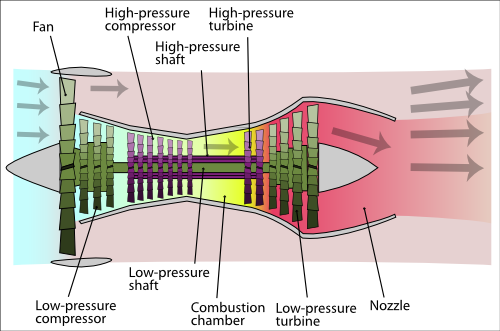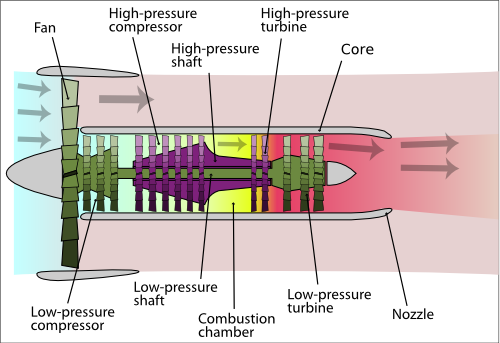Build a cheap turbofan
How to build a cheap (~ $150) turbofan?
Turbofan advantages over other propelling ways are that they provide enough trust to climb at high altitude, possibly at attractive speed, and that they are not much fuel-greedy and thus can be running for some time with limited extra-weight.
However they has the big disadvantage of being very difficult to manufacture as well as very expensive. On this page, we will explore how costs can be reduced, which will be the key for the decision to use turbofans or not.
General principles
Lots of information are available on Wikipedia's page. General principle is that there is a combustion that feeds a turbine, which drives the fan and the compression stage. The fan provides thrust from creating air pressure, and the combustion creates thrust by evacuating hot gas. As air is compressed from the intake, more air becomes available for combustion, and thus create more work on the turbine, and more intake.
Some design properties and configurations have to be properly calculated depending on the use of the engine, mainly for the intended aircraft speed:
- The Bypass ratio (BPR) is a ratio between the mass flow rate of air drawn in by the fan but bypassing the engine core to the mass flow rate passing through the engine core. A BPR = 0 would be a turbojet engine. The higher BPR, the more efficient the engine, but also the slower exhaust speed.
- The number of spools: it is often seen that a second concentric shaft for high pressure operations drives the low pressure shaft on which is mounted the fan. One stage engines exist and are less complicated and expensive to build, but are also less efficient. A gearbox may be needed to drive the fan if the low pressure shaft is still to fast.
- The compression ratio is determined by the number of stages in the compressor and its efficiency. More compression mean more air to blend with fuel, and even more pressure at output, increasing the speed and mass of output gas, and thus overall engine efficiency.
Turbojet/turbofan engine simulation software from NASA: EngineSim
A good book by Klaus Hünecke: Jet engines: fundamentals of theory, design, and operation
Video documentaries from a turbine renovator in Canada, probably the best resource on the Web for seing what's inside real engines: on youtube.
Design versus manufacturing
Design configurations and properties taken into concern on real engines tend to increase efficiency, i.e. higher thrusts for lower fuel consumption, but also try to reduce the exhaust noise. Cost is of course a concern, and an efficiency by itself, but not a constraint as important as it is for us. Safety of operation is their primary concern, whereas cost and ease of maintenance are our primary concerns.
Shaped core or shaped shaft?
An important optimization to reduce cost and complexity of manufacturing would be to have a simpler design of parts creating the internal volume of the turbine. In the above schema, we see that the shaft is straight and that the core envelope is curved to reduce volume on the high compression stage. If we take the same volumes on each part of the engine, and that we fix the envelope shape to a cylinder, the shaft has a bumped profile (small-large-small diameter). This is much less expensive to produce, with a simple lathe (turning). A curved envelope is complicated to build, requiring lot of welding, but is used in real-world engines.
Real-world engines don't have a massive turned shaft because of the weight. They consist of plates for each compressor and turbine stage, that are linked together to the next stage using a cylindrical bolted joint. So basically, the shaft has no core, and it's hollow, except for the plates on each stage. Our small engine design allows us to have a more simple design, since having a massively-turned shaft won't change much on its final mass. The issue is now how to properly fix the blades to it and how to balance it/them?
Compressor and turbine blades
The most complicated part to build in a turbofan or turbojet engine is the turbine and compression blades. The high-pressure turbine specially have to face very high temperature and pressure. On real engines, they are made of nickel-based superalloys.
The compressor is not only made of blades on the rotor, but also blades on the stator. They prevent a rotating air flow to form inside the engine, driven by the action of compressor blades. Stator blades redirect the airflow on the next compression stage in the more appropriate and efficient direction.
Highest efficiency is reached in turbofans when gaps are reduced between blades and the stator, or between the rotor and stator blades. As always, good efficiency means good high precision and higher cost. Anyway, the precision of blades will have to be very good if we don't want it to dislocate when it reaches the high rotations-per-minute achieved by the engines.
Open issues: what is the most simple yet efficient shape for turbine and compressor fan blades? Is a flat shape acceptable? Blades need to overlap or not? Should they be build in a single piece of metal along with the axis mount ring or assembled from blades on mounting rings? How to manufacture the blades?
Our design
Temperature control
Cooling might be needed if low cost metals are used. Expected combustion chamber temperature is around 2000°C for hydrocarbon or alcohol fuels. Iron melting point is around 1500°C...
Startup
Startup can be done at ground manually (with compressed air for example). Igniter has to be integrated to the engine, possibly a self-maintaining igniter like a thread of tungsten or something similar. The combustion should be self-igniting and self-maintaining, but if pumps or throttling lead to a discontinuous flow of fuel, the igniter will have to be available during the flight.
Sensors
Engine must be designed with sensors, at least to determine if the engine is running properly or if it's under failure. That can be done with a rotation sensor, measuring the magnetic field disturbances created by the blades or the rotor, possibly using a magnet (not recommended due to the manufacturing process and temperatures it may face). Engine temperature should be recorded too. Pressure at different stages would be very useful for engine development, then for behavior indications when running at high altitude, but may be too heavy or expensive to put on the real engine.
Fixing blades to rotor and stator
In real engines, blades are fixed like this, with a shape that allow them to be mounted and remove axially but not orthogonally. The main problem appearing with this kind of mount is related to the size of the engines we need. As the diameter of the fan shaft gets smaller, the available space for the blade inserts gets smaller, and require a higher precision for their manufacturing. Also, the beginning of the blade (out of the shaft) has to be linear and the insert has to be parallel to the shaft. It imposes the blades to be twisted between the inner part and the large outer part.
External hardware
Fuel tanks in the wings, fuel pumps, fuel lines, and engine mounting will have to be considered if turbofans are used. Sensors will require input ports on the computer, and pump driving (= engine control) will require at least one output port for each engine on the computer.

